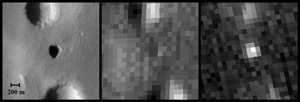
Figure 1Each of the three images in this set covers the same patch of Martian ground, centered on a possible cave skylight informally called "Annie," which has a diameter about double the length of a football field. The Thermal Emission Imaging System camera on NASA's Mars Odyssey orbiter took all three, gathering information that the hole is cooler than surrounding surface in the afternoon and warmer than the surrounding surface at night. This is thermal behavior that would be expected from an opening into an underground space.
The left image was taken in visible-wavelength light (figure 1). The other two were taken in thermal infrared wavelengths, indicating the relative temperatures of features in the image. The center image is from mid-afternoon. The hole is warmer than the shadows of nearby pits to the north and south, while cooler than sunlit surfaces. The thermal image at right was taken in the pre-dawn morning, about 4 a.m. local time. At that hour, the hole is warmer than all nearby surfaces.
Annie and six other features with similar thermal behavior are on the northern slope of a high Martian volcano named Arsia Mons, which is at 9 degrees south latitude, 239 degrees east longitude.
Mars Odyssey is managed by NASA's Jet Propulsion Laboratory, a division of the California Institute of Technology, Pasadena, for NASA's Science Mission Directorate, Washington. Lockheed Martin Space Systems, Denver, is the prime contractor for the project and built the spacecraft. The orbiter's Thermal Emission Imaging System was developed by Arizona State University, Tempe, in collaboration with Raytheon Santa Barbara Remote Sensing, Santa Barbara, Calif., and is operated by Arizona State University.

